From grizzly bears fishing in rushing streams to wolves prowling through snow-covered valleys, many of America’s national parks offer nature’s greatest wildlife show.
However, not all parks are equal and some definitely offer more chances to see wildlife than others.
So, if you really want animals and birds to be the focus of your next national parks trip, you’ll need to know which ones are best (and worst) to go to.
That’s what this article is all about. So, grab your binoculars and let’s see my top picks for the best wildlife national park in the US.
(I’ve also added a few national parks where your chances of seeing wildlife are slim, so you can give them a miss if that’s your main goal).
No time right now to see the worst and best national parks for wildlife viewing in the US? Pin It and save it for later:
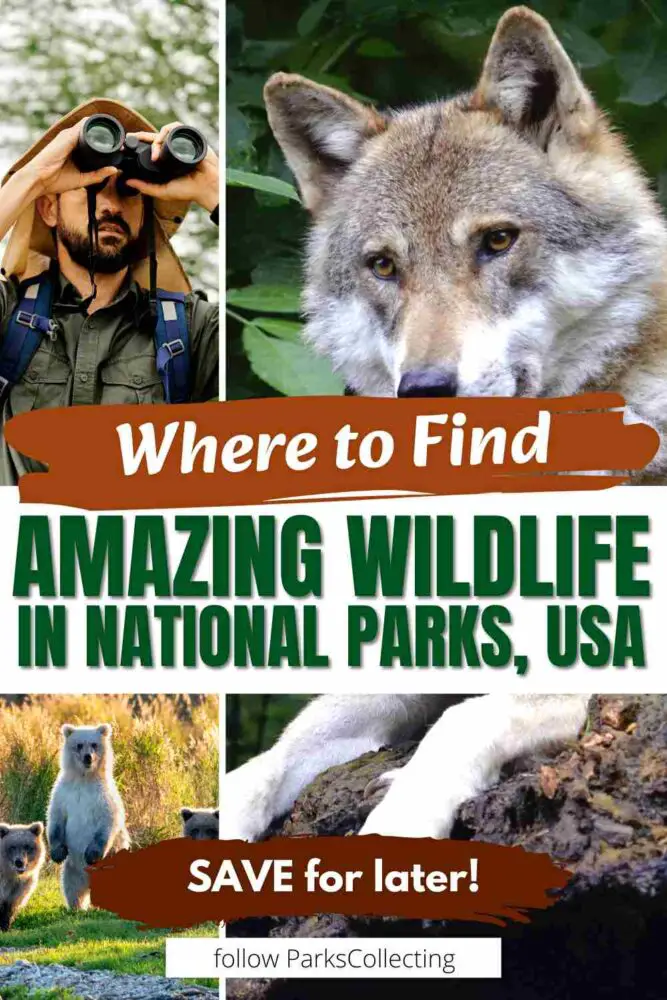
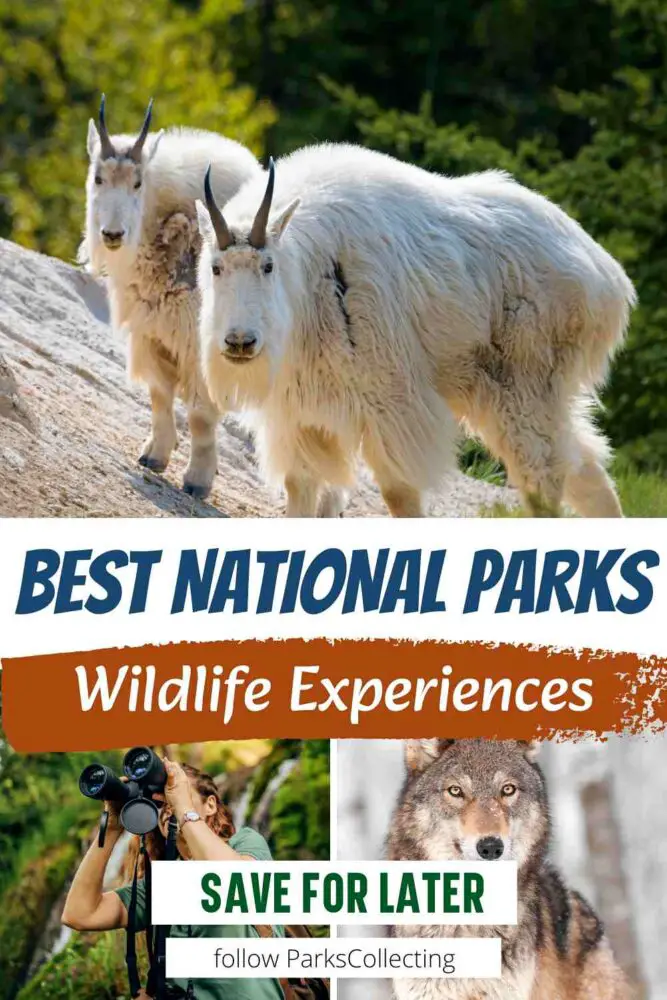
🛏️FIND A HOTEL: Search now
🚘FIND THE CHEAPEST CAR RENTAL: Search Discover Cars for the best deals
✈️FIND THE CHEAPEST FLIGHTS: Search Skyscanner for the best deals
🧳GET TRAVEL INSURANCE: Get insured with Travelex before you go
📱TAKE AN AUDIO TOUR: Buy an audio tour now
Subscribe to daily national parks planning tips, travel inspiration and trip ideas and I’ll send you a free PDF of this Guide:
The 10 Best National Parks for Wildlife Viewing in the US(and the 5 Worst Ones)
You need to keep a safe distance from wildlife, so check out my guides to:
➡️ The Best Binoculars for the Money
➡️ The Best Spotting Scopes for Wildlife Viewing
Table of Contents
1. Yellowstone National Park: Wyoming – Montana – Idaho
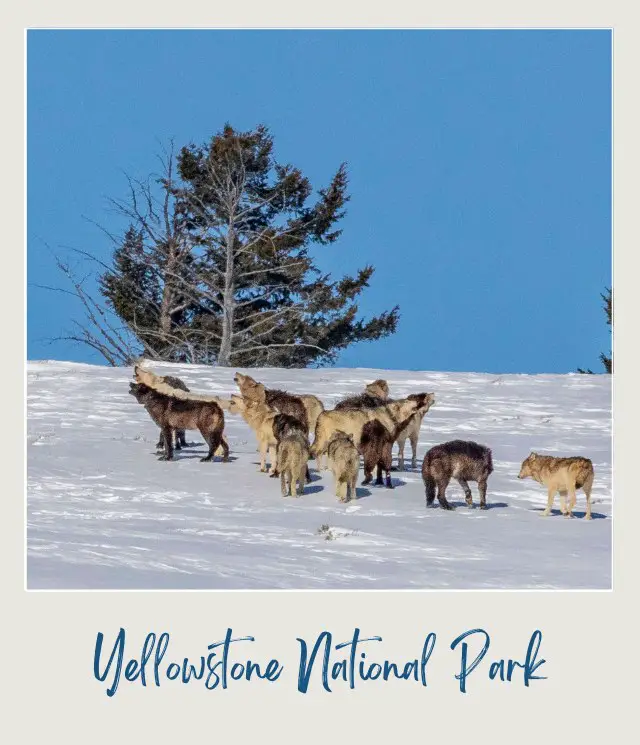
Why is this one of the best national parks in USA for wildlife?
Spanning over 2.2 million acres, Yellowstone boasts an impressive array of ecosystems, from lush forests to expansive grasslands. This diversity makes it a haven for a wide range of animals.
In fact, the park has the largest concentration of mammals in the lower 48 states and is often called “America’s Serengeti” due to the sheer number of animals there.
You’ll find iconic species like bison, elk, and grizzly bears roaming freely. Wolves, once nearly extinct in the area, have made a remarkable comeback, adding to the park’s rich tapestry of wildlife. The park’s geothermal features, like hot springs and geysers, also create unique habitats that support various species.
Whether you’re an avid wildlife photographer or just a nature enthusiast, Yellowstone offers an unparalleled opportunity to see these magnificent creatures in their natural habitat.
What Animals You Can See There
Some of the national park wildlife you can see in Yellowstone include bison, elk, wolves, grizzly bears, black bears, and bald eagles.
Where to See the Animals
Lamar Valley is the best place to see large herds of bison and elk, which attract elusive predators like wolves and bears.
Hayden Valley in the early morning or late afternoon is another excellent spot for viewing grizzlies and elk.
When to Best See the Animals
Spring and early summer are ideal times to visit, as animals are more active and visible after the winter. Early morning and late afternoon are the best times of day for wildlife viewing.
➡️ Read More: Yellowstone National Park Guide
️➡️ Buy: Detailed 1-4-Day Yellowstone Itineraries
2. Great Smoky Mountains National Park: Tennessee – North Carolina
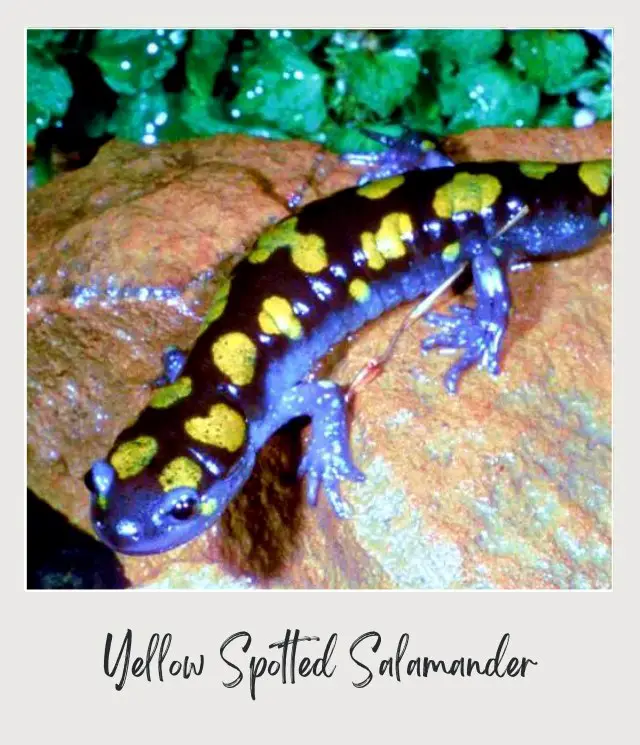
Why is this one of the best national parks to see wildlife?
Famous for its misty mountain scenery, the park is home to an incredible variety of habitats, from dense forests to open meadows. This diversity supports a rich array of wildlife, including black bears, white-tailed deer, and over 200 species of birds.
The park is also renowned for its synchronous fireflies, a rare natural phenomenon that draws visitors from all over.
With its mix of elevations and climates, Great Smoky Mountains National Park offers unique opportunities to see animals in different settings. The park’s extensive trail system allows for close encounters with nature, whether you’re hiking through lush valleys or ascending rugged peaks.
What Animals You Can See There
Black bears, white-tailed deer, elk, salamanders, and synchronous fireflies are some of the wildlife highlights.
Where to See the Animals
Cades Cove is a picturesque valley where open fields provide plenty of opportunities for animal encounters. The Cataloochee region is another great spot for seeing elk.
When to Best See the Animals
Spring is the best time to visit Cades Cove for sightings of white-tailed deer and black bears, often seen in mother-cub pairs. Elk are most visible in the fall during the rutting season.
➡️ Read More: Great Smoky Mountains National Park Guide
3. Denali National Park: Alaska
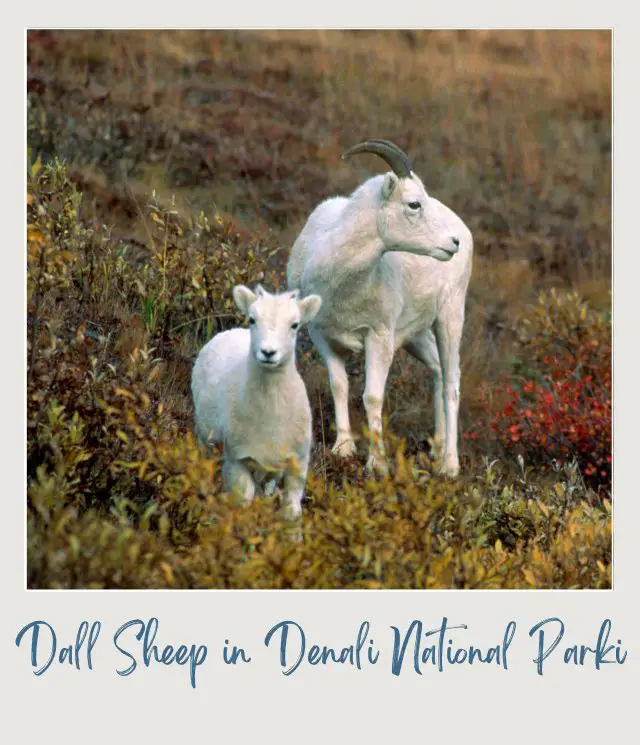
Why is this one of the best places to see wildlife in the US?
This remote Alaskan park is home to some of North America’s most iconic animals. You’ll have the chance to spot the “Big Five” – grizzly bears, moose, caribou, wolves, and Dall sheep in their natural habitats. The park’s different landscapes, from tundra to taiga forests, create a perfect environment for these creatures.
Denali is also a birdwatcher’s dream, with over 160 species of birds, including golden eagles and ptarmigans.
Take a park bus tour – the single road that traverses the park offers excellent wildlife viewing opportunities, often allowing visitors to see animals up close.
What Animals You Can See There
Grizzly bears, caribou, gray wolves, moose, and Dall sheep are commonly spotted.
Where to See the Animals
The park road, especially near the Toklat River area, is a hotspot for animal activity. The Savage River area is also excellent for wildlife viewing.
When to Best See the Animals
Late spring to early fall is the best time to visit, as the animals are more active and the weather is more favorable. Early morning and late evening are prime times for wildlife sightings.
4. Everglades National Park: Florida
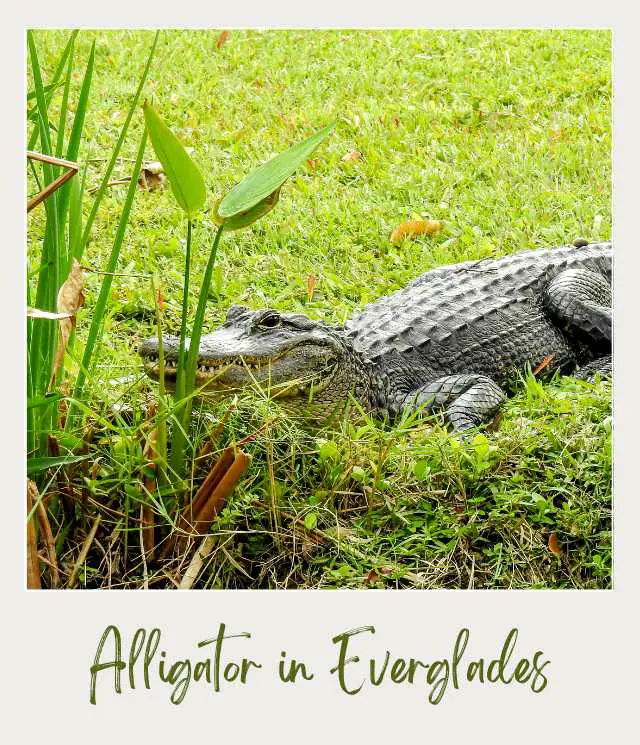
Why is this one of the best wildlife national parks in the US?
This subtropical wetlands in Florida are a critical habitat for a variety of species. Interestingly, Everglades is one of the most unusual ecosystems in the US, where alligators and crocodiles coexist peacefully. You’ll encounter American alligators, manatees, and maybe even the elusive Florida panther.
The park’s extensive network of wetlands and mangroves also supports an incredible diversity of birds, including roseate spoonbills, great blue herons, and wood storks. The Everglades’ slow-moving waters create a rich ecosystem that sustains a wide range of aquatic life.
Whether you’re exploring by airboat, kayak, or on foot, the park offers numerous opportunities to observe wildlife in their natural settings.
Bring bug spray though!
What Animals You Can See There
Alligators, crocodiles, manatees, dolphins, and the rare Florida panther are among the highlights. Bird species include herons, ibises, and roseate spoonbills.
Where to See the Animals
The Anhinga Trail is a popular spot for birdwatching. Boat tours provide close-up glimpses of manatees and dolphins. Shark Valley is another excellent area for viewing alligators.
When to Best See the Animals
Winter and early spring are the best times to visit, as the cooler temperatures and lower water levels make wildlife more visible.
5. Glacier National Park: Montana

Why is this one of the best national parks wildlife destinations?
Nestled in the Rocky Mountains, Glacier National Park’s dramatic landscapes provide a stunning backdrop for wildlife viewing.
The range of different habitats, from alpine meadows to dense forests supports a wide variety of wildlife, including grizzly bears, white mountain goats (the baby kids in spring/ early summer are super cute), and bighorn sheep. The park is also home to elusive species like lynx and wolverines, making it a prime location for spotting rare animals.
Birdwatchers will be thrilled with the park’s 276 species of birds, including peregrine falcons and harlequin ducks.
What Animals You Can See There
Mountain goats, bighorn sheep, black bears, grizzly bears, and moose are commonly seen.
Where to See the Animals
The Highline Trail is excellent for spotting mountain goats. Grinnell Glacier Trail is a good spot for seeing both black bears and grizzly bears. Many Glacier area offers opportunities to see a variety of wildlife. The Going-to-the-Sun Road offers excellent wildlife viewing opportunities, often bringing you face-to-face with these incredible creatures.
When to Best See the Animals
Late spring to early fall is the best time for wildlife viewing. Early morning and late afternoon are the best times of day to see animals.
➡️ Read More: Glacier National Park Guide
️➡️ Buy: Detailed 1-4-Day Glacier Itineraries
6. Olympic National Park: Washington
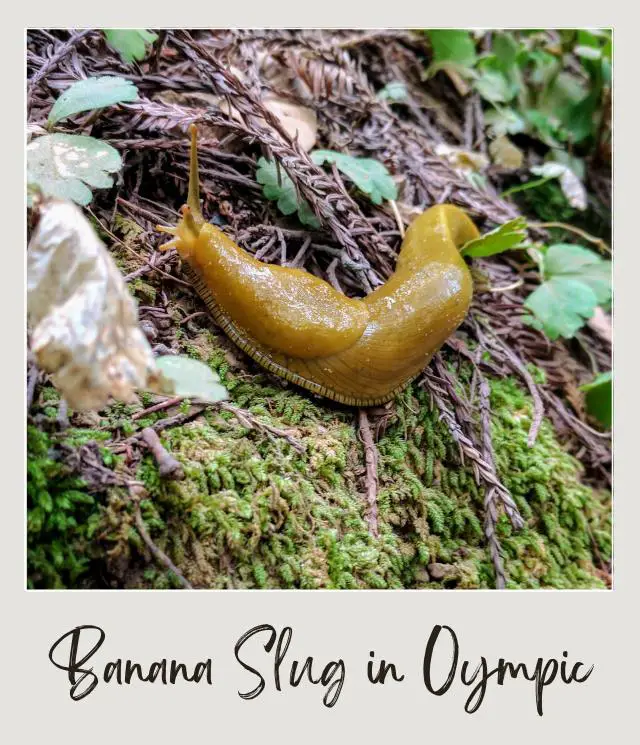
Why is this one of the best places for wildlife photography in the US?
The park spans nearly a million acres and four different ecosystems ecosystems, from rugged coastlines to temperate rainforests, lowland forests, and alpine peaks. This range of habitats making it one of the best places to see wildlife in the US.
Watch for Roosevelt elk, black bears, and mountain goats in the forests. The park’s coastal areas are perfect for spotting marine life like sea otters, seals, and even gray whales during migration seasons. And look for marmots in the mountains. Birdwatchers will be delighted with the park’s diverse avian population, featuring species such as bald eagles and marbled murrelets.
The diversity here really is amazing – I’ve seen everything from tiny banana slugs to massive bull elk.
What Animals You Can See There
Roosevelt elk, black bears, sea otters, whales, marmots, banana slugs, and a variety of seabirds are commonly seen.
Where to See the Animals
The Hoh Rain Forest is a prime spot for seeing Roosevelt elk. Ruby Beach is great for spotting sea otters and seabirds. The coastal areas are good for seeing seals.
When to Best See the Animals
Spring and early summer are ideal times for wildlife viewing, as animals are more active and visible. Early morning and late afternoon are the best times of day.
➡️ Read More: Olympic National Park Guide
️➡️ Buy: Detailed 1-4-Day Olympic Itineraries
7. Rocky Mountain National Park: Colorado

Why is this one of the top US national parks wildlife hotspots?
From lush valleys to towering alpine peaks, the Rocky Mountains support a rich assortment of wildlife, including elk, mule deer, and bighorn sheep. The park is also home to black bears, moose, and a variety of smaller mammals like marmots and pikas.
Bird enthusiasts will find plenty to admire, with species such as golden eagles and Clark’s nutcrackers soaring through the skies.
The park’s extensive trail network and scenic drives, like Trail Ridge Road, provide excellent opportunities to see these animals in their natural settings.
Fall here is spectacular – the elk rut brings out hundreds of animals. Listen for bull elk bugling across the valleys. Moose love hanging out in the willow thickets near the Colorado River. Dawn and dusk offer the best viewing chances.
What Animals You Can See There
Elk, moose, mule deer, bighorn sheep, and marmots are commonly seen.
Where to See the Animals
Trail Ridge Road is excellent for spotting larger mammals. Bear Lake and the alpine tundras are good for seeing marmots and pikas.
When to Best See the Animals
Fall is the best time to see elk during the rutting season. Summer is ideal for seeing bighorn sheep and marmots. Early morning and late afternoon are the best times of day.
➡️ Read More: Rocky Mountain National Park Guide
8. Grand Teton National Park: Wyoming
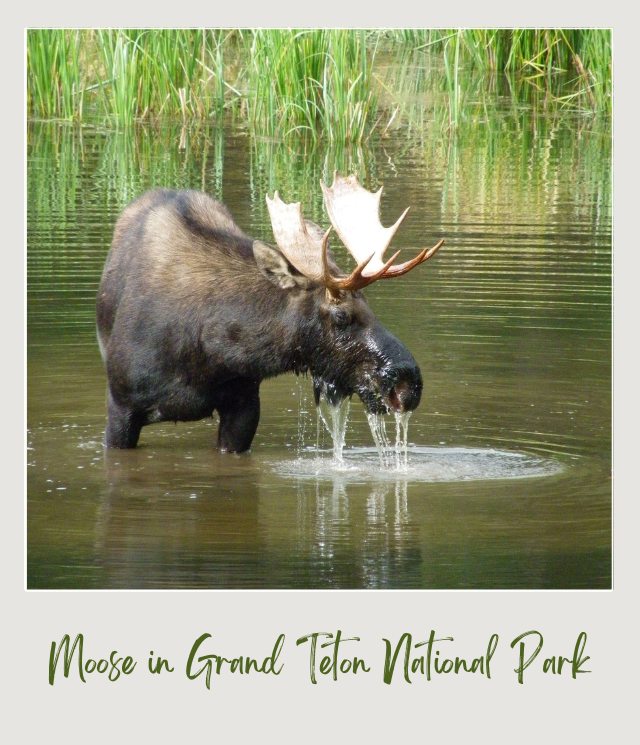
Why is this one of the most popular wildlife and national parks vacation places in the US?
The national park’s jagged peaks, lush valleys, and pristine lakes create ideal environments for all sorts of animals, including bison, elk, and moose. In fact, the Tetons offer some of the best moose watching I’ve experienced. Moose-Wilson Road is perfect for spotting these massive creatures, especially during fall.
The park is also home to predators like grizzly bears, black bears, and wolves, offering a rare chance to see these magnificent creatures in the wild.
The scenic drives and numerous hiking trails provide ample opportunities to observe wildlife up close.
What Animals You Can See There
Pronghorns, moose, bears, otters, and bison are often seen in the park. Birds commonly seen here include bald eagles, trumpeter swans, and ospreys.
Where to See the Animals
Willow Flats is excellent for spotting moose and grizzly bears. Mormon Row is good for seeing bison.
I’ve also seen moose at Schwabachers Landing and the appropriately named Moose Pond near Jenny Lake. Swing by Oxbow Bend at sunset – you might catch sight of eagles fishing or bears wandering the shoreline.
When to Best See the Animals
Spring and early summer are ideal times for wildlife viewing. Dawn and dusk are the best times of day.
➡️ Read More: Grand Teton National Park Guide
️➡️ Buy: Detailed 1-3-Day Grand Teton Itineraries
9. Theodore Roosevelt National Park: North Dakota
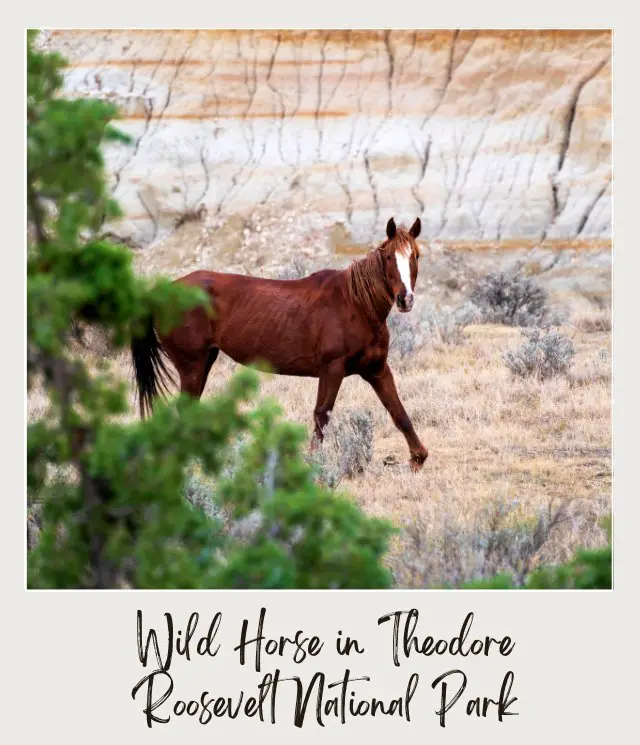
Why is this one of the top national parks for wildlife?
Theodore Roosevelt National Park is a hidden gem for wildlife enthusiasts. It’s much less crowded than many other parks on the list, but where else can you see wild horses gallop across the badlands? It’s like stepping back in time.
The prairie dog towns are super entertaining too, and bison herds roam freely. The park also supports a healthy population of elk and mule deer, making it a great spot for big game viewing.
The park’s scenic drives and numerous hiking trails are great for seeing these animals in their natural habitats.
What Animals You Can See There
Wild horses, bison, prairie dogs, elk, mule deer, white-tailed deer, pronghorn, coyotes, and various bird species, including golden eagles, western meadowlarks, and burrowing owls, and hawks.
Where to See the Animals
The park’s open grasslands and rugged badlands provide excellent wildlife viewing opportunities. The Scenic Loop Drive in both the North and South Units offers numerous pullouts and overlooks where you can spot bison and wild horses grazing.
Prairie dog towns are scattered throughout the park, and you can often see these lively creatures near the roadside. For elk and deer, the wooded areas along the Little Missouri River are prime spots.
Birdwatchers should head to the river valleys and high cliffs, where raptors like golden eagles and hawks are frequently seen.
When to Best See the Animals
Wildlife viewing is best during the early morning and late afternoon when animals are most active.
Spring and fall are particularly good times to visit, as the weather is mild and animals are more visible. During the spring, you can see young bison calves and other newborn wildlife. In the fall, the park’s elk are in rut, and you may hear their distinctive bugling calls.
10. Katmai National Park: Alaska
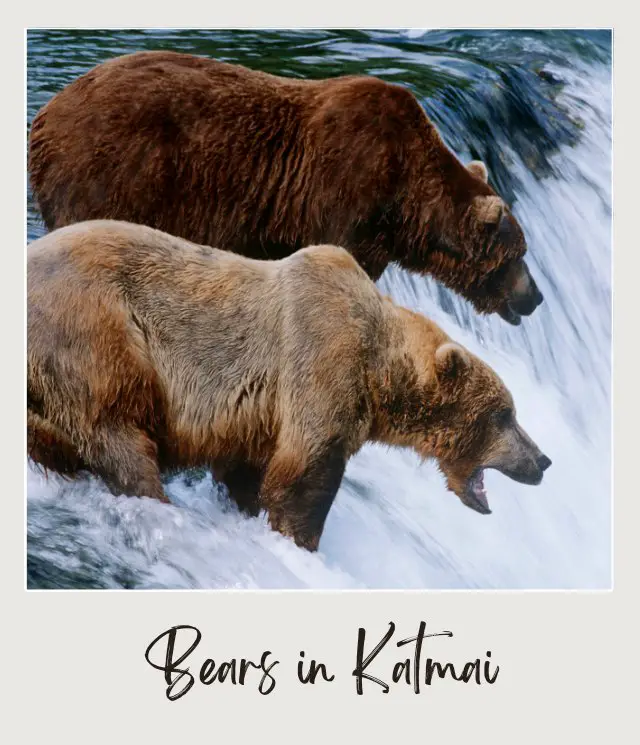
Why is this one of the best places to see wildlife in national parks?
Located in southern Alaska, the park is most famous for the Brooks River bears. This area is renowned for its large population of brown bears, which gather in significant numbers to fish for salmon during the summer months.
Besides bears, the park is home to a variety of other wildlife, including moose, caribou, and wolves. Birdwatchers will be kept happy with bald eagles and puffins, among many others.
The volcanic landscape, with its rugged terrain and pristine waterways, offers a stunning backdrop for wildlife observation.
What Animals You Can See There
Katmai is most famous for its large population of brown bears, which gather in significant numbers to feast on salmon. Other wildlife includes moose, wolves, and a variety of bird species such as bald eagles and puffins.
Where to See the Animals
Brooks Camp is the most popular spot for bear viewing, especially at Brooks Falls where bears can be seen catching salmon mid-air. The Valley of Ten Thousand Smokes offers opportunities to see other wildlife like moose and wolves, as well as stunning volcanic landscapes.
When to Best See the Animals
The best time to visit Katmai for bear viewing is from late June to September, with peak bear activity occurring in July when the salmon run is at its height. Early morning and late afternoon are the best times of day to see bears actively fishing.
➡️ Check out my Tips for Wildlife Viewing
5 Worst National Parks for Wildlife Viewing
Remember, these parks are still worth visiting for other reasons – amazing landscapes, unique geological features, or historical and/ or cultural significance.
They just might not be your best choice if wildlife watching is best in other locations. Instead, head to parks like Yellowstone or Denali for those memorable animal encounters.
1. Gateway Arch National Park: Missouri
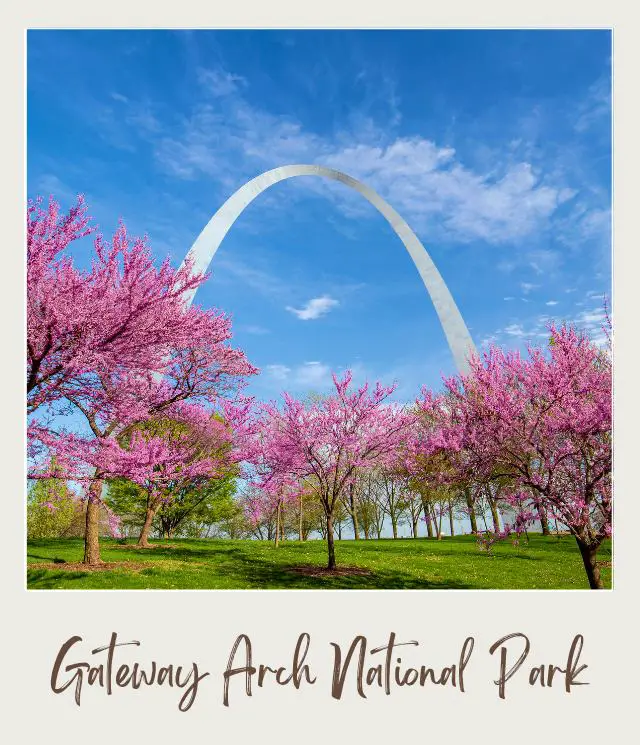
Located in downtown St. Louis, this urban park honestly isn’t your best bet for spotting wild animals. Shocking, I know!
While you might see some city birds and squirrels, the park’s main attraction is the 630-foot stainless steel arch. The most exciting wildlife encounter you’ll likely have here is watching pigeons land on the arch!
2. Hot Springs National Park: Arkansas
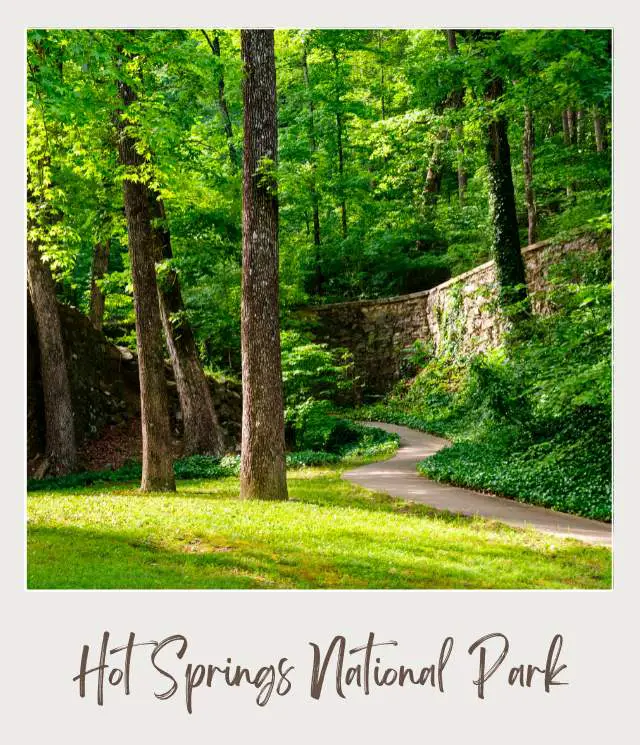
Arkansas’s Hot Springs focuses on its historic bathhouses and thermal springs rather than wildlife.
There are definitely fewer animals there compared to other parks. You might spot some small creatures like lizards or birds, but don’t expect the big wildlife encounters you’d get at Yellowstone or Denali. The park’s urban setting and smaller size limit animal habitats.
3. Indiana Dunes National Park: Indiana
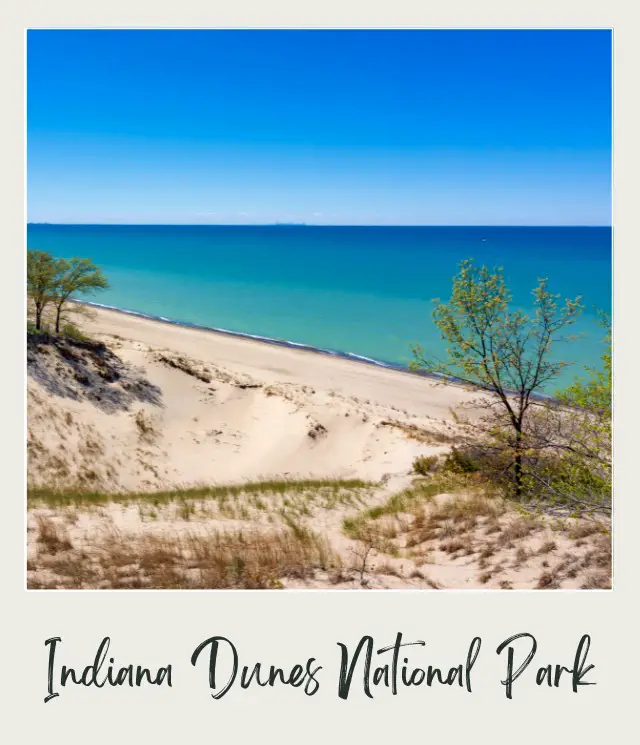
While Indiana Dunes offers excellent birdwatching opportunities (especially during migration seasons), it falls short when it comes to larger mammals. The park sits near industrial areas, which affects wildlife presence.
You’ll enjoy hiking the dunes and the lake views are stunning, but wildlife sightings are mostly limited to songbirds and small mammals like chipmunks.
4. Congaree National Park: South Carolina
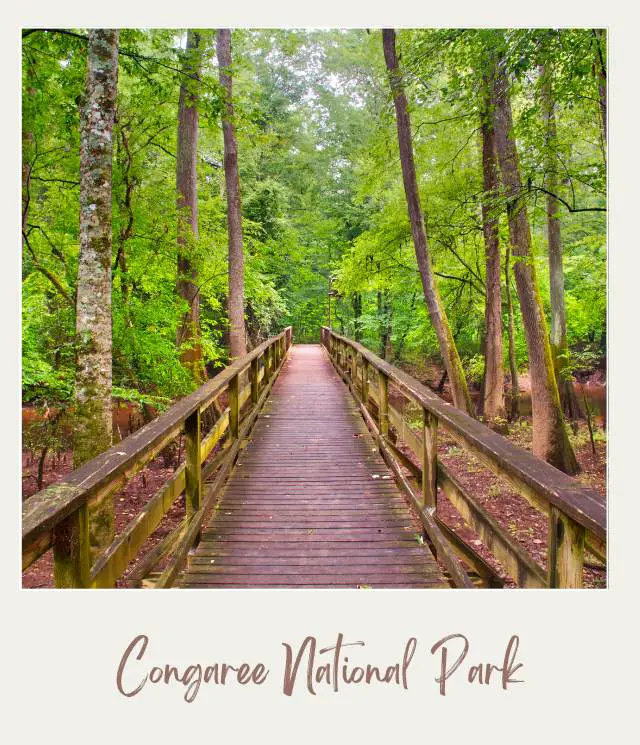
Here’s the thing about Congaree – while it technically has lots of species (362 per 100 square kilometers), actually seeing them is tricky. The dense forest canopy and swampy environment make wildlife spotting challenging.
So go and hike the boardwalks – the ancient trees are impressive – but larger animals often stay hidden in the thick vegetation.
5. Cuyahoga Valley National Park: Ohio
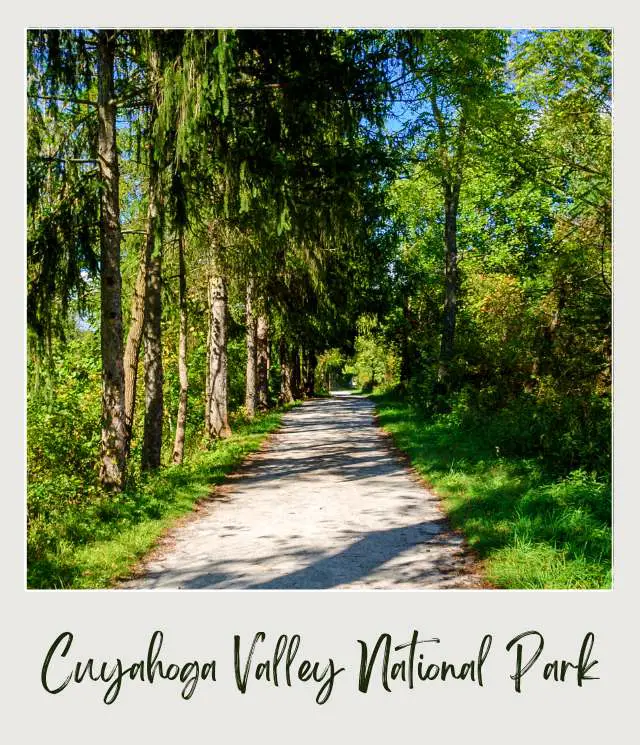
Don’t get me wrong – Cuyahoga Valley has wildlife, but sightings are less frequent than you might expect. The park’s location between Cleveland and Akron means more human activity, which affects animal behavior. You might see white-tailed deer or beaver activity near the river, but the big wildlife moments are rare.
Final Thoughts on Wildlife Viewing in National Parks
The magic of wildlife viewing in America’s national parks lies not just in the animals themselves, but in the complete immersion into their untamed world. Each park offers its own unique blend of creatures and experiences, from the dramatic bear encounters of Katmai to the peaceful grazing of bison in Yellowstone’s valleys.
What do you think is the best national park for wildlife viewing? Join my private Facebook group National Parks Collectors and comment and let me know (you can also pick up extra planning tips, share your photos and stories with other national park lovers and more).
Subscribe to daily national parks planning tips, travel inspiration and trip ideas and I’ll send you a free PDF of this Guide:
The 10 Best National Parks for Wildlife Viewing in the US (and the 5 Worst Ones)
If you liked this article about the top national parks with wildlife, Pin It to your National Parks board!


💡 Are you just starting to think about taking a National Parks trip? Get Inspiration
‼️ Do you need tips and additional information? Read a selection of tips for visiting US national parks
💻 Are you starting to plan a trip to a national park? Read my free guides
📋 Do you need an itinerary? Buy a detailed itinerary for your park
💲 Are you ready to book your trip? Use these Planning and Booking Resources
📖 Do you want to read a book about US national parks? Check out my Recommended Reading Lists
About the Author

James Ian is a national park, camping and hiking expert.
He has dedicated his life to travel, visiting more than 80 countries, all 7 continents and most of the national parks in the United States. With over 35 years experience in the travel industry, James has worked on cruise ships, at resorts and hotels, and as a travel planner who’s helped hundreds of people plan successful trips to US national parks.
Based on his experience visiting our national parks multiple times, in-depth research and expertise as a travel planner, James has published detailed itineraries for many of the major national parks in the US. These itineraries, as well as in-depth park guides, and other resources will help you have your own incredible trip to US national parks without stress and hassle.
As a national park expert, James has contributed to many publications, including USA Today, Newsweek, Time Business News, Savoteur, Best Trip, and Wired.
I’m a member of the Amazon Services LLC Associates Program. As an Amazon Associate I earn from qualifying purchases.
